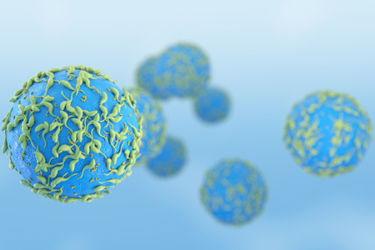Preparing Your CAR-T Therapy For Phase 2 Trials

By Tyler Menichiello, Chief Editor, Bioprocess Online

AffyImmune Therapeutics is a clinical-stage biotech focused on developing CAR-T cell therapies for solid tumors. The company’s lead candidate, AIC100, is an ICAM-1 targeting CAR-T therapy intended to treat anaplastic and relapsed/refractory thyroid cancer (ATC). At the heart of AIC100 is AffyImmune’s “Tune and Track” platform, which enables affinity-tuning and in vivo tracking of CAR-T cells.
Following the announcement of positive Phase 1 data earlier this year, I met with AffyImmune CEO, Matt Britz, at Meeting On The Mesa to discuss what’s next for the company, as well as the challenges it’s faced along the way. We talked about the company’s clinical strategy, the technology behind AIC100, and the unavoidable headache that is tech transfer.
Tune And Track Technology

“Historically, what a lot of people did was arm CAR-T cells with very high-affinity antibodies, so you get this very high-affinity interaction between CAR-T cells and tumor cells,” Britz explains. “And while that works great in vitro, when you put very strong-affinity CAR-T cells into humans, that CAR-T cell will also attack healthy cells that express a low level of the target, and that results in toxicity.”
Another problem with high-affinity CAR-T cells, he tells me, is their potential for exhaustion. Preventing CAR-T cell exhaustion may be the key to providing a more sustained therapeutic effect — as long-term follow-up studies show that higher peak-blood levels of CAR-T cells correlate with a longer duration of response. When affinity is too high, however, CAR-T cells can become overactivated and consequently, depleted. “You get good initial killing of cancer cells, but if they don’t get them all, and whenever the tumor starts regrowing, there are no longer any CAR-T cells left to fight the battle.” This can lead to a patient’s tumor relapsing.
When it comes to finding the affinity “sweet spot,” Britz says, there are a handful of approaches — from screening potential candidates for affinity to performing targeted mutations and assessing the changes. “Basically, it’s starting with something that binds to your target and then making subtle modifications until it binds in the way you want it to.” By finding this sweet spot, AffyImmune aims to develop CAR-T cells that exhibit decreased off-target toxicity and avoid exhaustion.
The other half of AffyImmune’s platform, the tracking feature, allows CAR-T cells to be imaged in vivo. “We’re the only people that know where our CAR-T cells are in people in real time,” Britz says. By co-expressing a membrane protein (SSTR2) that interacts with an FDA-approved imaging agent (gallium 68 dotatate), AffyImmune is able to track its CAR-T cells through PET scans. The idea behind this feature is to better manage toxicities by identifying off-target sites of CAR-T cell activation. However, according to Britz, “we always see our CAR-T cells lined up with the tumors in places they’re supposed to be.”
Be Strategic About Your Target Indication
Britz explains that going after AIC100’s target indication (ATC) is a part of the company’s “land and expand” strategy. “We want to be one of the first solid tumor CAR-T companies to get approval,” he says. Acknowledging that other companies are ahead in the game, he continues, “One of the ways you can get ahead is by going into a rare disease where you need fewer patients to get approval. We looked around and said, ‘where are high ICAM-1-expressing cancers with a lot of unmet medical need?’”
This brought the team’s attention to ATC, which is associated with increased levels of ICAM-1 expression and currently has no standard of care. “This combination of a small patient population and an ineffective standard of care became very important for us to be able to show that AIC100 works,” he explains. AffyImmune’s plan is to prove efficacy in this initial, smaller indication before going into other ICAM-1 expressing cancers.
Naturally, targeting a rare disease affects your clinical strategy. While it’s difficult to recruit for rare diseases, “it’s also hard to recruit for a trial if there are 500 other drugs in that cancer space,” Britz says. “When you’re a small company competing in early Phase 1, you’re going to lose to Big Pharma small molecules. That’s somewhere we didn’t want to be — with an ongoing study that we couldn’t recruit.”
When conducting trials, especially in the rare disease space, Britz says, it’s important to geographically organize clinical trial sites to ease the travel burden on patients. When he took over operations of AffyImmune, it was a single-site trial. “A single-site clinical trial was not going to work for us,” he says. “We had to go where the patients were.” Now, there are sites in New York (Cornell Medical School), Texas (MD Anderson), California (City of Hope), and Illinois (Northwestern Medicine).
Selecting Your CDMO And Preparing For Tech Transfer
AffyImmune is currently gearing up to begin its Phase 2 trial. “We haven’t had any dose-limiting toxicities so far,” Britz tells me, knocking on the wooden table. Moving forward, he says, the biggest challenge — as with any small biotech — is funding. Aside from that, he says, a big part of preparing for Phase 2 trials involves leveling-up the manufacturing.
“We’re going the CDMO route, but that’s also a challenge,” he explains. The company is in the midst of a tech transfer, having identified a new CDMO to carry them through Phase 2 and hopefully to commercialization. AffyImmune was previously working with an academic CDMO, which Britz says was more cost-effective for Phase 1. “One of the reasons for that is the FDA requires you to only dose one patient at a time during a Phase 1 trial,” he says. “So, if you can only dose one patient every 30 days, and something happens to the patient where they can’t get dosed, that’s a huge delay. If you’re paying a suite rental fee, you can really burn through cash very quickly.”
Academic CDMOs (e.g., university hospitals or comprehensive cancer centers with manufacturing capabilities) generally charge per-patient as opposed to charging for a suite rental, which makes them preferable partners for Phase 1. However, moving into Phase 2 and beyond — as the number of patients (and demand for product) grows — Britz says it makes more sense to rent a suite.
When it comes to selecting a CDMO, it’s important to make sure their team has the experience and capabilities to manufacture your product. Of course, this means they also need to have the space to do so. “A lot of CDMOs did not have suite space that was going to be ready by the time we needed it,” Britz tells me. “I think that’s changing today, but it was pretty much a deal breaker. If you’re not able to be up and running by the time our Phase 2 starts, we just can’t use you.”
Location also played a big role in AffyImmune’s CDMO selection. “If you want a successful tech transfer, you need to have people and plans to work with the CDMO. So, you want to have somewhere that’s easy to get to for your current staff, or somewhere they would like to go,” he says. “If there’s any problem that comes up, you’re going to be able to solve it a lot quicker if you’re on site.” For this reason, he says, AffyImmune chose to work with a local CDMO.
As with any change in your CDMO, tech transfers are inevitable, and Britz says companies would be wise to prepare for them as early as possible. He suggests budgeting at least a year. “You need at least a quarter for contracting and a year for the tech transfer itself, at a minimum,” he says. The company started preparing for this shift to Phase 2 shortly after efficacy was shown in Phase 1’s increased dosing level. “When we got that partial response, for us, that was kind of the go moment.”
With tech transfers come unavoidable problems and fires to put out. “I would be shocked if you talked to anybody who said their tech transfer went smoothly,” Britz says. While you can’t anticipate every challenge that will arise, there are some you can avoid. One avoidable (yet, often overlooked) snag in tech transfers comes from failing to upgrade your company’s analytics. As you move into Phase 2, he says, it’s imperative that you focus on analytical development and upgrading your assays. “Make sure that the assays you propose and are currently using in Phase 1 are Phase 2 ready. People tend to put that off because it’s not currently on fire. You can get away with it in Phase 1, but you’re only buying time — you still have to solve the problem.”
